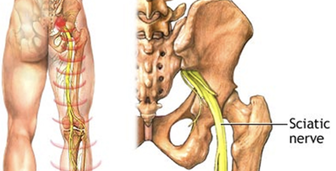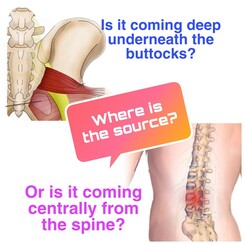 Are you someone presenting with back pain that never seem to go away? Maybe you have been to a few different therapists, tried various medications prescribed, yet the niggling feeling on your back just never seem to go away, which often feel like it’s tight, sometimes achy. [...] Just the other day, one of our back pain client was asking us as to, "What the differences were between Sciatica and Piriformis syndrome?" This particular client, felt radiating pain down to the bottom of her left foot for about three months before she met us - she was suspecting what she’s experiencing could be either one of them. Now, before I go any further, I will list out few key points as to why Sciatica and Piriformis syndrome can always be mistaken for one another. 1. They present radiating (spreading/ distributed) pain.
2. Both have something to do with the Sciatic nerve being extra sensitive.
3. Same areas that may potentially get affected.  Like what mentioned in the previous point, since the Sciatic nerve is involved, chance is that the path where Sciatic nerve innervate will be affected as well. Now, if you do not know where the sciatic nerve is. It’s probably the most common nerve that you heard of before... Sciatic nerve is also the largest nerve in the body. Innervating at the back of your thigh. So far, does all the above pointers sound familiar to you? If yes, this is what’s going to make the difference for you to at least get closer to the answer you’re looking for.  1. The only difference is the exact source where it’s from. Sciatica is from nerve root L4/L5/S1, piriformis is from the small muscles that’s deep underneath the glute max (our big buttocks). When it gets tight, it can cause the nerve to become sensitive. In fact, Piriformis syndrome is sometimes known as the pseudo-sciatica. Pseudo as in fake. 2. Piriformis syndrome – triggers symptoms on one side of the lower limb. Sciatica can potentially trigger symptoms on both side as the true source is actually coming centrally. Due to the location of their source, there’s high potential if the spine (which is the central) is not happy, it can start producing symptoms on both ends. Whereas there is chance that piriformis can also cause symptoms on both ends, it will be two separate piriformis that got triggered (often at two different times). Last but not least, although these two may have different name. The approach will not vary much. Strategy is the same. So what should you do? I always love to tell my client this – aim to centralize the pain. I rather have the pain centralized at your back feeling it at a higher intensity of pain, as compared to small sensation on the toes or down the legs. Your chance of recovery gets better when you can send the pain back up, regardless the intensity. But beware, as the pain goes up, and become more localized close to the source of pain, it can get intense (for some). It’s something to be expected. It’s good news, don’t panic. If you have this problem and find your back pain difficult to solve, or still couldn’t find out if it’s sciatica or piriformis syndrome difficult, leave it to the professionals with proper guidance from expert. Click on the button below and talk to one of our team members today!
1 Comment
SAMUEL
12/20/2023 10:17:31 am
Your attention to detail and meticulous research are evident in every paragraph. If you're a research enthusiast, <a href="https://4dbd4jqj3i1zdy5je3ggkz7tzi.hop.clickbank.net/?cbpage=text" target="_blank">click here</a> for a list of scholarly articles and studies on the topic.
Reply
Leave a Reply. |
Fu TonPhysiotherapist sharing with you the general knowledge on common injuries you're facing and how to free yourself off it. ArchivesCategories
All
|




 RSS Feed
RSS Feed